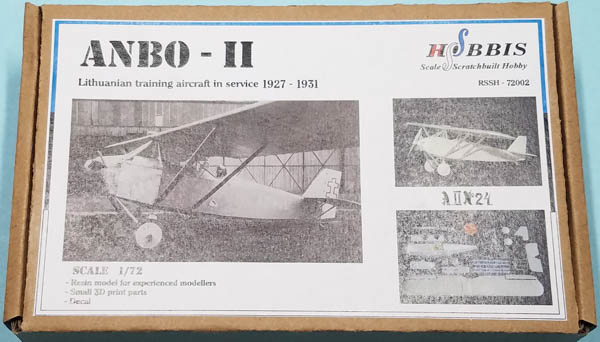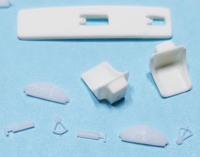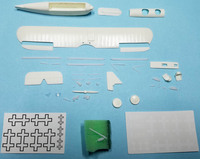
RSS-Hobbis 1/72 Gustaitis ANBO-II
By Matt Bittner
Overview
Just a short time ago I reviewed the Hobbis 1/72 Gustaitis ANBO-I. Hobbis has been creating Lithuanian-designed 1/72 aircraft models for a short time, and they have turned their attention to the Gustaitis ANBO-II.
The ANBO-II was another monoplane designed during the time of biplanes and appeared to fare well. Taken from the site History of Lithuanian Aviation 1919 - 1940, with translation provided by Google:
"Being a supporter of monoplanes, A. Gustaitis, already presenting a sketch project, tried to convince the superiors that a monoplane is also easy to drive and does not complicate flying training, and that there are already training planes of such a scheme - high-wing monoplanes (for example, the French "Moran" ). A. Gustaitis chose the "Parasol" scheme for his training plane, of course, also because he predicted that most of the planes of the Lithuanian Air Force would probably have the same scheme: his training and reconnaissance ANBOs."
"in 1927 construction began in the summer, and within three months the plane was almost complete. The only thing missing, but very important, was the Walter NZ engine, the production and delivery of which was delayed. Having nothing else to do, A. Gustaitis decided to fly to Riga with his first ANBO. Having left on October 19, Kaunan returned after a few days' stay with the Latvian brothers. Meanwhile, Czech engine Walter NZ N r. 10,243 factory tests were done on October 22 only. and then sent Lietuvon. In the first days of November, the engine was installed in the plane, and on November 10. A. Gustaitis made his first flight with ANBO-II. Approved by a commission appointed by the Chief of Military Aviation as a training aircraft, it was used for the training of military pilots in 1928-30 until the engine and canvas covering of the wings and fuselage wore out. in 1931 during the overhaul of the engine, changing the covering of the wings and fuselage, the old chassis of the plane, which had been broken several times, was replaced with a more modern one (like ANBO-III) - not with a continuous wheel axle, but with half axles. As in 1927, the aircraft's factory and service (board) number remained the same - 24."
For a more comprehensive history on the ANBO-II, definitely visit its page on the aforementioned History of Lithuanian Aviation 1919 - 1940 site. Note that there was only one ANBO-II created, but it gave way to the highly produced ANBO-V and ANBO-51, a type all Lithuanian pilots trained on.
The Kit
The Hobbis 1/72 ANBO-II consists of 39 pieces of cream and white resin (some 3D printed), two clear windscreens and a decal sheet with Lithuanian crosses - black and white (the white is put down first, left to dry then the black overlayed on top of them) - and the "A.II No.24." text for the fuselage sides. The molding on this kit is exquisite and some of the best resin casting I have ever seen.
Since the fuselage is one-piece, the cockpit consists of a floor, two seats, two instrument panels, two engine primer pumps and two engine controls. In fact, these must be seen to be believed. They are 3D printed and too scale! Such exquisitely printed parts that will need a delicate touch. While there is no color mentioned for the cockpit it appears the fuselage was linen covered with a wood coaming around the top of the cockpit. In addition, the inside cockpit tubing structure was metal, so could have been left natural, or painted black. There are no seat belts provided.

|
Once the cockpit pieces are added then the top of the fuselage is glued to the main body. The instructions show adding the windscreens and the engine cylinders at the same time, but I would wait until final construction and after painting. In the next stage the prop, underside scoop and underside fuselage section added. I definitely will wait to add the prop and underside scoop until after painting; I can see me popping off the scoop and since it's such a small part, it would definitely be lost.
The instructions now show adding the wing and all its struts, the landing gear and wheels along with the tail surfaces, struts and tail skid. You'll need to pay attention to the last instruction step and actually consider it your first step to pay attention to: it shows using wire for the prop shaft, cockpit control sticks and posts for the rudder/fin.

|
Note the instructions don't have a rigging diagram. Unfortunately the ANBO-II photo section on the History of Lithuanian Aviation 1919 - 1940 site is "under construction" but you could reference the manufacturer's Scalemates page for how he finished his prototype kit. It shows all rigging (and control horns, also not included in the kit) needed to make this a complete ANBO-II.
Conclusion
Unlike the ANBO-I, I see the ANBO-II could take a little longer in construction. That's due to its parasol design including all struts and rigging. But even still, this could build quicker than most other models as all parts are already "processed" for you (meaning you don't have to remove the parts from any type of "support structure" and clean them up) and there aren't a lot of parts. I'm looking forward to finishing this and adding it to my Lithuanian aviation collection.
Note there are two boxings from Hobbis of the ANBO-II: this boxing, showing how it was finished from 1927-1931; and the other boxing containing markings for how it looked during the 1931-1934 time frame, when it was flown by The Aero Club of Lithuania.
If interested in obtaining any of the Hobbis models, including this ANBO-II, email them direct at rss.hobbis@gmail.com.
